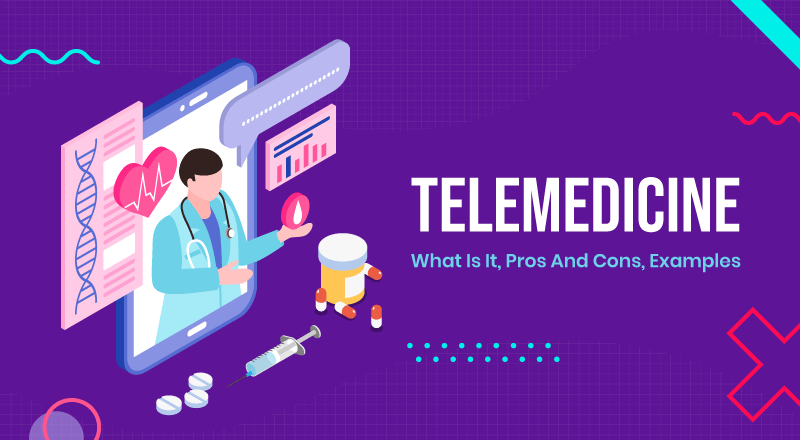Telemedicine: What Is It, Pros And Cons, Examples

We are almost relying on digital for communicating, collaborating, and conducting major business functions in this coronavirus pandemic. In every field, the ability to adapt virtual considered as ‘essential’ rather than any ‘backup’ plan. From eLearning to eHealth and from virtual offices to online events, technology has helped everyone to achieve better accessibility, speed, and efficiency.
Technology is proven indispensable for the majority of the fields including healthcare. There are more advanced, accessible, and accurate solutions that help health professionals, governments, hospitals, researchers, and doctors to study, diagnose, and access better resources and services.
Like education, better healthcare is every human’s right, and both developed and developing countries are making every effort to make it affordable, accessible, and cost-effective.
Technology plays a huge role here. It has also played a very significant role against COVID-19 by enabling remote options as well as effective communication.
Recognizing the role of technology in the healthcare industry, here, we will be talking about Telemedicine which has greater benefits and potential to transform how healthcare services will be delivered.
What Is Telemedicine?
Telemedicine refers to the use of telecommunications technology to deliver healthcare to patients in real time. It can be delivered through video conferencing, audio communication, text/chat, or using healthcare apps.
How Telemedicine Works?
- Using telecommunication technology, physicians and patients can discuss issues/symptoms
- Share information (visuals, screen, and text) in real-time
- Remotely consult doctors and get a diagnosis
- Capture or see readings from medical devices
- Get a prescription for primary treatment
- Educate patients, consultants, or healthcare professionals
Who Can Use Telemedicine Technique?
- Doctors
- Supervisors
- Patients
- Consultants
- Healthcare Professionals
History Of Telemedicine: Healing From A Distance
The World Health Organization (WHO) describes telemedicine as “Healing from a distance.”
This refers to the freedom of getting treatment without stepping out from your home to visit a doctor.
The first application of Telemedicine was in 1905 by a Dutch physician as mentioned in the book, titled History of Telemedicine: Evolution, Context, and Transformation, by Gary William Shannon And Rashid Bashshur.
According to the book or several other resources over the web, the transmission of radiographic images started in the 1950s in the United States. With the never-ending changes in technology and advances in the healthcare industry, telemedicine observed concurrent evolutions over time.
What Are The Types Of Telemedicine?
There are three types of telemedicine delivered to patients and these are:
It involves the use of technological healthcare devices to monitor health and is very useful in the management of chronic conditions such as heart disease, diabetes, asthma, and many more. It is also known as ‘telemonitoring’ which allows health professionals to monitor patients’ activities and conditions remotely.
This is more like medical advice, anytime, anywhere without visiting a doctor in person. Real-time video calls, phone calls, or texts can be used for consulting, discussing issues, seeking primary advice, follow-up meetings, or checking conditions of chronic illness. There are special apps for this purpose where patients and providers use secure software to see and hear each other. This method is very popular for accessing rapid primary healthcare.
In this type of Telemedicine service, all the history, diagnosis, images, tests, and videos are stored and forwarded to healthcare providers who use this information to treat patients after a period of time. This is often useful for rural areas where patients need a specialist or advanced health care at another location and this information can be shared with them. This can save a lot of time and cost.
Fun Fact: Telemedicine first started on landline telephones.
Pros And Cons Of Telemedicine
Benefits Of Telemedicine For Patients:
Telemedicine, at its primary level, is an alternative to in-person visits and offers benefits to both, patients and providers.
With the help of Telemedicine, patients don’t need to travel and visit the doctor personally. This saves a lot of time, and cost, and patients can get early access to better healthcare regardless of where they are.
Many telemedicine apps are HIPAA compliant and emphasize patients’ privacy through secure channels, one-to-one conversations, and reliable medical services.
-
No Risk Of Exposure To Any Contagion
The use of telecommunication technology to treat patients reduces the risk of exposure to any contagious diseases thereby, limiting the spread of infectious diseases when applied at a large scale or in situations like a global pandemic.
-
More Convenient And Cost-effective Healthcare
This model removes geographical barriers and allows access to convenient, cost-effective, and better healthcare for everyone. For patients who have mobility issues or suffering from chronic diseases where regular monitoring is important, telemedicine is very beneficial as they can access healthcare services without stepping outside of their homes.
Benefits Of Telemedicine For Providers:
-
Better Outcomes And Quality Healthcare
It makes it easier for providers and physicians to deliver better healthcare as patients can connect with their consultants more frequently and discuss any issue/advice. Primary doctors can also easily contact specialists or suggest expert consultants on their health conditions. They can easily follow up, resulting in a faster, better, and more convenient healthcare system.
-
Increased Patient-Doctor Engagement
With the advancement in technology and hyper-connected environment, today’s patients anticipate better care faster and telemedicine offers the same. Healthcare providers and patients can connect more often, more questions can be asked and answered, resulting in a stronger bond between them.
-
Offers Job Satisfaction Of Providers
Meeting patients becomes easy with the use of telemedicine and providers can enjoy work-life balance and spend more time offering the best services.
Some of The Disadvantages of Telemedicine:
Telemedicine has several obvious benefits to healthcare providers and patients as well. But, as a coin has two sides, Telemedicine has some cons also.
As it is majorly dependent on technology, it can cause troubles and interrupt treatment in situations like bad weather, lack of electricity/power, and technical constraints.
-
Not Suitable For All Treatments:
It is great for regular checkups and primary consultation but in some cases like a physical checkup, an injury or throat infection, or anything where objects and primary actual observation are needed, Telemedicine is not sufficient. In such cases, you will be required to visit a doctor.
-
Technical & Equipment Training:
Physicians, medical staff, health care professionals, and practitioners all are required to be trained on new systems, equipment, and IT requirements. There will be an increased cost of hiring IT staff and purchasing equipment.
The global telemedicine market is valued at USD 87.41 billion in 2022 which is expected to grow significantly in the coming years, reaching a value of USD 286.22 billion by 2030.
The popularity of telemedicine is growing day-by-day and insurance companies are thinking of including this type of service in their plans. There are many telemedicine apps available in the market.
Some Of The Famous Telemedicine Applications:
- Doctor On Demand
- MDLIVE
- Doxy.me
- Lemonaid
- PlushCare
- LiveHealth
Telemedicine vs Telehealth: What is The Difference Between Telehealth And Telemedicine?
Telehealth and Telemedicine – these modern healthcare approaches have played a significant role in the time of the COVID-19 pandemic. Entire states and cities were under strict lockdown and travel restrictions were enforced worldwide to stop transmission of this deadly disease. Corona has adversely affected healthcare and innovative solutions are needed to deliver better healthcare services. Telehealth, in this respect, has the potential to become an alternative to healthcare where distance is a concern.
These terms are often used interchangeably and have subtle differences between them.
Telehealth and Telemedicine – both terms are used in a similar perspective sometimes. Telehealth is used in a wider and broader sense as it covers all health-related technologies and services to provide better-quality healthcare to patients. On the other hand, Telemedicine is used in a limited sense and refers to the use of telecommunication technologies to deliver remote healthcare services such as consultation, remote diagnosis, and monitoring.
Telehealth vs Telemedicine:
| Parameters |
Telehealth |
Telemedicine |
| Definition |
An umbrella term that covers healthcare services, telemedicine, administration, health education, and research |
Provision of healthcare service using information and communication technologies (ICT) (remote clinical services) |
| Scope |
All-encompassing and broader |
Narrower than telehealth |
| Examples |
Remote health sessions, health education for professionals, wireless medical adherence, remote patient monitoring |
Remote monitoring and consultation, remote video conference, remote management of patients’ conditions, diagnosis, tele treatment |
| Specific Use |
Technologies for overall well-being and better healthcare services |
Use of technologies for illness and chronic conditions, counseling, home health care, and remote medication |
| Service Focus |
Clinical/non-clinical services |
Only clinical services |
| Types/Methods |
Live video conferencing, Remote Patient Monitoring(RPM), Mobile Health(mHealth), Asynchronous video(store-and-forward) |
Store-and-forward, remote monitoring, and real-time interactive services |
| Key differentiator |
Not all telehealth is telemedicine |
All telemedicine is telehealth |
Have You Tried It?
Telemedicine doesn’t mean you will never visit the doctor again. This can be used primarily in chronic conditions when you have to go for regular checkups. In the first place, it’s affordable, easy, and accessible and streamlines the services for both providers and patients.
Whether patients have a busy schedule, stay in remote areas, or do not have enough time for checkups and monitoring, telemedicine can help improve patients’ health and well-being.
Frequently Asked Questions
These services are billed using CPT codes and HCPCS codes. According to India’s New Telemedicine Practice Guidelines, telemedicine consultation should be treated in the same way as in-person consultation from a fee perspective.
Instead of an in-person visit, a telemedicine visit is the use of video or telephone communications to offer clinical services to the patients.
Medical imaging, video consultations, remote medical diagnosis and evaluations, tele-treatment, and medication management are some of examples of telemedicine.
Asynchronous telemedicine refers to the store-and-forward technique where information such as medical history, reports, images are collected by a physician and sent ahead for specialized treatment.
Yes, it is covered by the health insurance policy under OPD expenses provided your policy covers OPD expenses.
SPEC INDIA is your trusted partner for AI-driven software solutions, with proven expertise in digital transformation and innovative technology services. We deliver secure, reliable, and high-quality IT solutions to clients worldwide. As an ISO/IEC 27001:2022 certified company, we follow the highest standards for data security and quality. Our team applies proven project management methods, flexible engagement models, and modern infrastructure to deliver outstanding results. With skilled professionals and years of experience, we turn ideas into impactful solutions that drive business growth.
Delivering Digital Outcomes To Accelerate Growth
Let’s Talk






